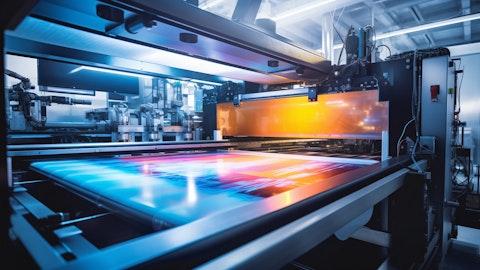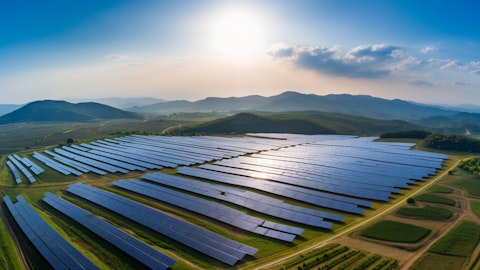Hallador Energy Company (NASDAQ:HNRG) Q3 2025 Earnings Call Transcript November 10, 2025
Hallador Energy Company beats earnings expectations. Reported EPS is $0.55, expectations were $0.06.
Operator: And good afternoon. Thank you for attending Hallador Energy Company’s Third Quarter 2025 earnings conference call. At this time, all participants are in a listen-only mode. Following our prepared remarks, we will conduct a question and answer session, and instructions will follow at that time. As a reminder, this call will be recorded. I would now like to turn the conference over to Sean Mansouri, the company’s NIR. Please go ahead, Sean.
Sean Mansouri: Thank you, and good afternoon, everyone. We appreciate you joining us to discuss our third quarter 2025 results. With me today are President and CEO, Brent Bilsland, and CFO, Todd Telesz. This afternoon, we released our third quarter 2025 financial and operating results in a press release that is now on the Hallador Investor Relations website. Today, we will discuss those results as well as our perspective on current market conditions and our outlook. Following prepared remarks, we will open the call to answer your questions. Before we begin, a reminder that some of our remarks today may include forward-looking statements subject to a variety of risks, uncertainties, and assumptions contained in our filings from time to time with the SEC and are also reflected in today’s press release.
While these forward-looking statements are based on information currently available to us, if one or more of these risks or uncertainties materialize, or if our underlying assumptions prove incorrect, actual results may vary materially from those we projected or expected. In providing these remarks, Hallador has no obligation to publicly update or revise any forward-looking statements, whether as a result of new information, future events, or otherwise, unless required by law to do so. And with the preliminaries out of the way, I’ll turn the call over to President and CEO, Brent Bilsland.
Brent Bilsland: Thanks, Sean. And thank you, everyone, for joining us this afternoon. We are very pleased with our strong third quarter results, which reflect the continued momentum of our strategy and the operational resilience of our vertically integrated platform. During the quarter, we delivered significant third quarter year-over-year gains across key financial metrics, including revenue, which increased 40%, net income increased 14 times, and adjusted EBITDA, a non-GAAP measure, increased 1.6 times. The current market signals for our product offerings are strong, and we believe that the robust interest in the types of long-term arrangements that we are currently evaluating justifies attempting to increase generation at our Meramec site.
In connection with these strong signals, on November 3, we took a meaningful step in our strategy to grow our generation portfolio by submitting an application to the MISO expedited resource addition study, or ERAS program, seeking to add an additional 525 megawatts of gas generation at our Meramec site. While the application is only a first step in our growth process and does not guarantee that we will be able to add the full load or any additional generation as part of ERAS, we’re excited to participate in the opportunity and for what it could mean to the future of Hallador. Favorable summer weather patterns, coupled with higher energy demand and elevated natural gas prices, created a supportive energy pricing environment that drove strong revenue, more than a 29% year-over-year increase, for our Hallador Power subsidiary.
Following the completion of Unit Two’s annual maintenance outage in early July, both units operated very well through the quarter, resulting in higher dispatch levels and improved reliability across the system. These conditions also provided a tailwind for our coal operations, where solid production, up 18%, increased shipments, and consistent operating costs contributed to our strong results, which demonstrated the operating leverage inherent in our coal operation. The favorable power markets led to higher dispatch at both Meramec and our customer plants, which boosted coal shipments and helped reduce fuel inventories at both our power plant and coal mine. During the quarter, we also executed a $20 million prepaid forward power sales contract with delivery scheduled through 2027.
As we have stated in the past, these types of sales are a key component of our commercial strategy, providing immediate liquidity while monetizing forward pricing. The prepaid proceeds are being used to support ongoing operations and capital investment across the company. As the quarter progressed, we saw accelerating interest in our capacity and energy offerings from both data center developers and load-serving entities seeking access to the limited inventory of large-scale dispatchable energy available in the coming decade. We are in advanced discussions on multiple fronts and remain encouraged about achieving positive progress towards an agreement by early 2026. Each potential counterparty brings unique value creation opportunities and challenges, but all share a recognition of the importance of securing reliable, accredited capacity.
Many of the opportunities that we are evaluating are long-duration, meaning a decade or more in length, and would likely consume the majority of the plant’s energy output and accredited capacity at favorable prices. The evolving energy landscape, driven by rapid data center growth, rising demand from load-serving entities, and a more supportive regulatory environment, is creating opportunities that simply did not exist when we began our RFP process last year.
Todd Telesz: We recognize that these opportunities are time-sensitive, and our team remains focused on securing an agreement that maximizes value for Hallador and our shareholders. While we continue to view an agreement with a load-serving entity as the more straightforward and faster path to execution, we’re also seeing meaningful progress on the data center side, particularly with developers that have proactively secured critical infrastructure such as step-down transformers, switchgear, and other site-level equipment. From a broader market perspective, we continue to see the structural imbalance created by the ongoing retirement of dispatchable generators like coal in favor of intermittent renewables such as wind and solar.

This shift has increased the scarcity and value of reliable baseload generation. We believe this environment enhances the long-term value of our Meramec power plant, its leverageable infrastructure, and the critical role that the site plays in supporting grid stability. As a result, in addition to our efforts to participate in the ERAS program, we continue to evaluate strategic opportunities to acquire additional dispatchable generation assets and infrastructure that could help diversify our portfolio, add scale, and enhance our growth trajectory. We also continue to assess the potential to add natural gas co-firing capabilities to our existing generation facilities at Meramec. A dual-fuel configuration could enhance resiliency during periods of limited gas availability while allowing us to continue leveraging the competitive advantage of our own fuel supply through Sunrise Coal.
We are proceeding given the regulatory and consumer considerations that will determine the ultimate structure and timing of this type of opportunity. Operationally, Hallador Power delivered 1,600,000 megawatt hours during 2025 at an average sales price of $49.29 per megawatt hour, compared to 1,200,000 megawatt hours at $47.55 per megawatt hour during the same period in 2024. As indicated in our forward sales position, we are transitioning into a period of higher energy and capacity pricing above our historical rates as demand for reliable baseload power continues to grow. On the coal side of our business, operational consistency and increased shipments helped reduce inventories while maintaining adequate fuel supply to support higher potential dispatch levels during the upcoming winter season.
As of now, we expect to produce 3,800,000 tons of coal in 2025, having produced 3,100,000 tons through the first nine months from our Oaktown mining complex. We also continue to strategically supplement our internal coal production with low-cost third-party purchases, providing flexibility to respond quickly to shifts in demand and pricing. This balanced approach enables us to optimize fuel costs at Meramec while maintaining optionality to capture upside in coal markets. The transformation of Hallador from a commodity-focused coal producer to a vertically integrated independent power producer is evident in our results. We are leveraging the energy transition to capture the expanding margins of the power markets and the growing demand for reliable electricity.
If we are able to successfully navigate the associated challenges with building new generation, we believe that the ERAS program provides an opportunity for meaningful organic growth in a relatively accelerated time frame as compared with traditional builds. With the potential to add roughly 50% of additional generation capacity to the Hallador fleet, we are excited by the unique opportunity this presents. The continued influx of interest from data centers and load-serving entities underscores the value of our platform, and we believe Hallador is well-positioned to take advantage of these opportunities for step-function growth and cash flow generation in the years to come. I will now pass the call over to our Chief Financial Officer, Todd Telesz, to take you through our financial results.
Todd?
Todd Telesz: Thank you, Brent. Good afternoon, everyone. Jumping right into our third quarter results. On a segment basis, electric sales for the third quarter increased 29% to $93.2 million compared to $72.1 million in the prior year period, while coal sales increased 42% to $68.8 million for the third quarter compared to $48.3 million in the prior year period. Electric sales in Q3 benefited from traditional summer weather patterns, increased energy demand, and higher natural gas prices, which together create a supportive energy pricing environment. The increase in coal sales during the third quarter was driven by increased shipments to customers, supported by favorable power markets that led to higher dispatch levels at both Meramec and our customers’ power plants.
On a consolidated basis, total operating revenue increased 40% to $146.8 million for the third quarter compared to $105.2 million in the prior year period. Net income for the third quarter increased substantially to $23.9 million compared to $1.6 million in the prior year period. Operating cash flow for the third quarter increased to $23.2 million compared to cash used of $12.9 million in the prior year period, with the increase primarily driven by the aforementioned favorable energy pricing environment, improved coal production efficiencies, and the $20 million prepaid forward power sales contract executed in Q3 2025. Adjusted EBITDA, a non-GAAP measure, which is reconciled in our earnings press release issued earlier today, increased 1.6 times to $24.9 million for the third quarter compared to $9.6 million in the prior year period.
We invested $19.6 million in capital expenditures during 2025, compared to $11.6 million in the year-ago period, bringing our total 2025 year-to-date CapEx to $44.3 million. As of 09/30/2025, our forward energy and capacity sales position was $571.7 million, compared to $619.7 million at the end of Q2 and $685.7 million at 12/31/2024. When combined with our third-party forward coal sales of $350 million, as well as intercompany sales to Meramec, our total forward sales book as of 09/30/2025, was approximately $1.3 billion. Our total bank debt remains relatively unchanged and was $44 million at 09/30/2025, compared to $45 million at 06/30/2025 and $44 million at 12/31/2024. Total liquidity at 09/30/2025 was $40.4 million, compared to $42 million at 06/30/2025 and $37.8 million at 12/31/2024.
We are currently in discussions with members of our existing bank group and other potential lenders to refinance our credit agreement. Our revolving credit facility matures in August 2026, and our term loan matures in March 2026, with the remaining balances scheduled for repayment in the first quarter of that year using restricted cash. While we have not yet finalized terms, we are making progress towards refinancing on market-based terms and conditions consistent with our existing facility. Of course, as with any financing, there can be no assurance of timing or final terms and conditions, but we remain confident in our ability to secure an arrangement that supports our ongoing liquidity and growth initiatives. This concludes our prepared remarks.
We’ll now open up for questions from those participating on the call. Operator, back to you.
Q&A Session
Follow Hallador Energy Co (NASDAQ:HNRG)
Follow Hallador Energy Co (NASDAQ:HNRG)
Receive real-time insider trading and news alerts
Operator: Thank you. As a reminder, to ask a question, you will need to press 11 on your telephone. To remove yourself from the queue, you may press 11 again. First question comes from the line of Jeff Gramp of Northland Capital Markets. Your line is open, Jeff.
Jeff Gramp: Afternoon, guys. Hey. This is Brent on the potential capacity expansion you guys are looking at now. What are the main milestones or key long lead items we should think about to track over the next, I don’t know, couple quarters, six to twelve months, to kind of assess the progression there, the potential?
Brent Bilsland: Thanks. Yes. So MISO created this expedited process to help generation that meets the requirements, which basically has the potential or likelihood to actually be built, get through the queue process in a timely fashion versus the traditional process. And so we found an application that we feel complies with those timelines. They will come back later this month and tell us if our application is complete in their eyes and give us the time to cure anything that needs further clarification. Then they are at various times of the year announcing which applications they’re picking up to review. The ERAS program only allowed for 50 total applications. And I think back in August, they came out and said they were reviewing, like, nine of those applications.
I think here in November, they’ve come out and said they’re doing another 15 or so. And so it could be six months or so before they actually pick ours up. So that’s something that we’ll keep an eye on and certainly update the market at our quarterly filings. And then in the meantime, we’re working on securing the equipment that we filed to build. And so that’s what we’re working on for now.
Jeff Gramp: Perfect. That’s really helpful. And for my follow-up, you guys obviously had a super strong quarter in Q3. Can you touch on what you’ve seen in the first forty-ish days of Q4? Just trying to get a sense of if some of these dynamics have continued or how we should think about Q4 expectations as we look to wrap up the year?
Brent Bilsland: Yes. No. Q3 was an exceptional quarter for us. A lot of things went right. We had units coming out of outage. We had really warm weather providing strong cooling demand in September. And coal shipments were just quite frankly exceptional. We do not expect that here in Q4. We expect Q4 to look very much like Q4 of 2024. Unless we just see some extreme cold weather show up in December or something like that. We don’t see much of a catalyst to really drive a performance like Q3.
Jeff Gramp: Got it. That’s helpful. I’ll hop back in the queue. Thanks.
Brent Bilsland: Thank you, Jeff.
Operator: Thank you. Our next question comes from the line of Matthew Key of Texas Capital. Please go ahead, Matthew.
Matthew Key: Hey. Good afternoon, everyone, and thanks for taking my questions. I was wondering if you could provide any initial color on the economics of the 525 megawatt expansion, just like an initial read on CapEx and any potential impact it could have on operating costs long term.
Brent Bilsland: Yeah. So we are still negotiating the equipment for that. And so until we have those economics secure, we’re not really releasing any information as far as the overall economics. But you know, we are encouraged by what we see through our long-term negotiations on PPAs about the robustness of volume and pricing and number of bidders. The market is just sending strong signals that it needs more capacity. And so that’s ultimately what led us to the decision to file. And so as we progress through this process over the next three years, we’ll continue to update all of our investors on what that project’s gonna look like. But we’re excited about the opportunities. We’ve told investors it’s when you’re a smaller company like ourselves as far as being able to grow your production relatively quickly. And we think this project potentially does that with the potential to increase our generation by 50%.
Matthew Key: Got it. That’s helpful. And just a quick macro question for me. In late September, the Trump administration announced I think it was $625 million in funding directed at coal-fired power in the US. What impact, if any, do you think they’ll have on the industry? And could Hallador potentially be a recipient of any of that funding?
Brent Bilsland: Yeah. I mean, look. I think anytime the government is handing out money, that’s helpful to the industry. And I think that Hallador could have some projects that qualify for grants out of that basket of money. So we’ll just have to see. It’s, you know, they made an announcement, then we figure the rules out as we go. So we’re still trying to navigate that process and see how much of that we can secure for Hallador.
Matthew Key: Great. Appreciate the time, and best of luck moving forward.
Brent Bilsland: Thank you, Matt.
Operator: Thank you. Our next question comes from the line of Jacob G. Sekelsky of AGP. Please go ahead, Jacob.
Jacob G. Sekelsky: Hey, guys. Thanks for taking the question. Just on the M&A front, you mentioned you’re always looking. I’m just curious if you’re seeing, you know, plug-and-play type capacity additions out there. Are you more still looking at assets that have been started with capital and in need of investment? And I guess any color if you have a preference between the two.
Brent Bilsland: Well, I think, you know, typically, you’re probably gonna find us play in the coal space. That seems to be our niche, our expertise. And traditionally, there’s been less competition there. So that’s typically where we like to focus our attention. That said, those types of transactions are very bespoke. And so they take more time. And I come back to the Meramec purchase. I mean, that took us NDA to closing. Signing the NDA to closing was thirty-three months. So it wasn’t a small amount of work, but that said, it ended up being a tremendous value to the company. So those are the type of circumstances that we’re looking for. I don’t think we’ll find a purchase price that low again, but the revenue to offset that has increased. And so we just have to take the opportunities as they come. But we are encouraged by some of the conversations that we’re having. We’ll see if they develop.
Jacob G. Sekelsky: Got it. Okay. That’s helpful. That’s all for me. Congrats on the quarter.
Brent Bilsland: Thank you, Jacob.
Operator: Our next question comes from the line of Nick Giles of B. Riley Securities. Your line is open, Nick.
Nick Giles: Hey. Thanks, operator. Good evening, everyone. Guys, congrats on a really nice quarter here. Brent, in your prepared remarks, you noted advanced discussions with multiple parties. Would you look to reenter into exclusivity? Would you really be focused on just announcing a definitive agreement at this point? And then, you know, last quarter, spoke to utilities entering the mix. So curious for any updated commentary around that if a utility might be your preference or if you’re still, you know, kinda in the mix with hyperscalers as well. Thanks.
Brent Bilsland: Well, we’re talking to both parties. What’s changed is the utility interest has increased. Quite frankly, everybody’s interest has increased. And I think that’s due in large part, particularly on the developer side, as their projects start to get through permitting. And, you know, once they can get the land permitted and project zoned for data center build-outs, then they start focusing their attention on the next step, which is energy. And so we’re seeing several of those projects kinda make it through those stages and now turn their attentions on Hallador because, again, as we’ve said before, we think we’re one of the few places to get accredited capacity in the state of Indiana or MISO Zone 6 in another way.
So that’s what’s transpired, and so it’s definitely piqued the interest here in the last several months. And it’s far more than interest. I mean, we are negotiating with several parties, and we’re trying to get to a definitive agreement with all of those. And they’re on probably more of a time constraint than we are. So, you know, they’re trying to get to a project to the point where it can be developed as quickly as possible. So I think we’re in a good spot. We’re very encouraged by the process and how it’s going and what we see, so much so that that led us ultimately to the decision to try to grow our generation by 50% through the ERAS process.
Nick Giles: Right. That’s helpful. Maybe switching gears. You executed a five-month prepaid forward for $20 million in the quarter. How much more room do you have in your forward book until you feel like you need to preserve the remaining capacity for a long-term agreement? Just curious on that in the course that had.
Brent Bilsland: Well, that was energy. Right? Primarily with the market, it is really strong, sending the strongest signal for the credit capacity. You see a lot of articles about the world’s running out of energy. I disagree with that. The world has run out of accredited capacity. So and the sale we really made was for the 2027 time frame, which we hadn’t done much out there, and it was really for a relatively small volume.
Nick Giles: Got it. Maybe just one more if I could. Is it fair to assume that this 525 megawatt expansion could be a part of any long-term agreement, or maybe if not initially, could you see that potential customer having a rover on the capacity? Or where does this ultimately fit in, if at all?
Brent Bilsland: Well, it’d be interesting to see. I mean, we just went public about the project an hour ago. So it’s not something we’ve discussed with other parties. I mean, we just made the filing a week ago. So this is all relatively new, and, you know, we want to—that’s part of the reason we wanted to publicly announce. But when you make a filing like that, you’re never really quite sure when that will become public. So we wanted to tell the market at the same time. And then so I think it will be part of our conversations going forward. And we’ll see where that leads.
Nick Giles: Got it. Well, Brent and team, appreciate the update, and continue the best of luck.
Brent Bilsland: Thank you, Nick.
Operator: I would now like to turn the conference back to Brent Bilsland for closing remarks. Sir?
Brent Bilsland: Yes. I want to thank everybody for joining us today and your continued interest in Hallador, and just hope that we’ve been able to articulate and express our high level of excitement as we’ve had a great quarter, and we’re excited about the opportunities that are in front of us. Thank you.
Operator: Ladies and gentlemen, this concludes today’s conference call. Thank you for participating. You may now disconnect.
Follow Hallador Energy Co (NASDAQ:HNRG)
Follow Hallador Energy Co (NASDAQ:HNRG)
Receive real-time insider trading and news alerts




